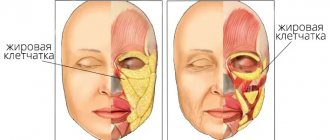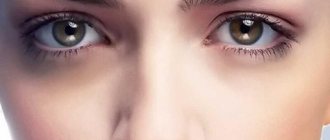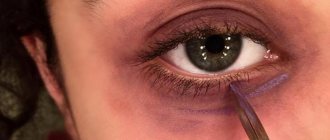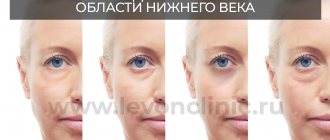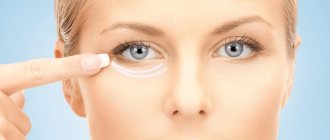The eyes are called the mirror of the soul, so it is not surprising that many people first of all pay attention to them. Circles forming under the eyes cause women many problems and worries. They try to disguise the flaw with the help of correctors and foundations. But this way cannot solve the problem. You can only hide it, and only temporarily. In order to radically eliminate the defect, it is necessary to first determine the cause, conduct a diagnosis and, only based on the results obtained, select treatment methods.
Causes of the defect
All known factors that can provoke the formation of dark circles around the eyes are divided into 3 groups:
Lifestyle
Quite often, circles under the eyes appear due to an unhealthy lifestyle:
- poor nutrition leading to vitamin deficiency;
- insufficient water consumption;
- strong insolation;
- constant lack of sleep;
- frequent stressful situations;
- sitting for many hours in front of a computer monitor.
Therefore, most people are at risk. But it is the factors of this group that are easiest to eliminate, since they are reversible and easily corrected.
Diseases of internal organs
Dark circles under the eyes can occur in people with impaired venous or lymphatic drainage. The cause of such conditions is insufficient blood supply (ischemia) and oxygen deficiency (hypoxia). As a result, metabolism is disrupted, causing insufficient nutrients to reach the cells. Therefore, dark circles are often noticeable in people with diagnosed diseases of the cardiovascular (coronary heart disease, vascular insufficiency) and bronchopulmonary (chronic bronchitis, tuberculosis, sarcoidosis, fibrosing alveolitis) systems.
In patients suffering from anemia, the number of red blood cells decreases and the concentration of hemoglobin decreases, which is why the tissues do not receive enough oxygen. At the same time, the reduced hemoglobin accumulates and gives the blood a dark color, which explains the change in color of the skin around the eyes.
Pathologies of the hepatobiliary system (cholecystitis, cholelithiasis) increase the level of bile pigment (bilirubin) in the blood. As a result, the skin in the periorbital area becomes pigmented and turns yellow-brown.
Damage to the thyroid gland (including hypothyroidism) causes a lack of oxygen in the body, which causes bruises to appear under the eyes. In this case, other signs are observed: hair loss, unbearable heat and cold, weakening of attention and memory, drowsiness, lethargy, rapid fatigue.
Diseases of the nasopharynx (sinusitis, sinusitis, chronic tonsillitis, adenoiditis) dilate the blood vessels, which leads to their excessive filling with blood and blueness of the skin under the eyes.
In acute infectious diseases accompanied by an increase in body temperature, intoxication occurs with the metabolic products of microbes. As a result, the acidity of the blood increases and acidosis develops, in which the vessels dilate and their permeability increases. Intoxication syndrome causes dehydration. On dry and thin dehydrated skin, dilated capillaries become especially noticeable, which creates the effect of dark circles.
Diseases of the adrenal glands and kidneys increase pigmentation of the skin surrounding the eyes. With chronic adrenal insufficiency (Addison's disease), the skin also darkens in natural folds (groin, palms) and in areas exposed to friction by clothing (lower back, neck). With kidney pathologies (pyelonephritis, glomerulonephritis), blue circles under the eyes become noticeable when the disease relapses due to a malfunction of the organ.
Women often suffer from hyperpigmentation during hormonal changes (during pregnancy, menopause) due to an imbalance of female sex hormones (estrogen, progesterone).
In case of inflammatory eye diseases (conjunctivitis, iridocyclitis), swelling appears under the eyes, the permeability of capillaries increases, which is why they become more noticeable and begin to “see through” the skin.
With vegetative-vascular dystonia (the so-called polyetiological syndrome, which is not a disease), bruises under the eyes also often form. At the same time, other signs appear: migraine, dizziness, asthenia, cardialgia, changes in heart rate and breathing, swelling of tissues, tremors of the hands, coldness of the extremities, feeling of heat in the face, sleep disturbance, fainting, neurotic disorders.
The maximum number of mast cells accumulates in the periorbital region, which causes the reactivity of the skin surrounding the eyes and frequent allergies. In diseases of an allergic nature (allergic rhinitis, hay fever), blood vessels dilate and their permeability increases, as a result of which the skin under the eyes darkens.
Hereditary predisposition
This group includes people who lead a healthy lifestyle and do not have health problems. For them, dark circles under the eyes are the norm. This problem is more common in women with very dry and dark skin.
It should be noted that the risk of hyperpigmentation of the skin in the periorbital zone increases with the use of tetracyclines, sulfonamides and oral contraceptives.
All of the above factors are enhanced by excessive exposure to ultraviolet radiation. In this case, the defect becomes stable and difficult to treat.
Homeopathy against dark circles under the eyes in men
Homeopathy remedies are part of complex therapy; they do not eliminate the symptom, but heal the person. They will help get rid of annoying dark circles under the eyes in men, specifically targeting the source of the problem:
- Belladonna (Belladonna) - helps eliminate cough during bronchitis, especially dry smoker's cough;
- Antimonium crudium (Antimonium crudum) - taken for problems of the gastrointestinal tract, also eczema;
- Bellis perennis (Bellis perennis) - helps with bruises, including increased pigmentation around the eyes;
- Absinthium (Absinthium) - taken for an excited nervous system and sleep disorders;
- Apis mellifica (Apis mellifica) – eliminates kidney inflammation;
- Acidum picrinicum (Acidum picrinicum) - helps with conjunctivitis and eye inflammation due to fatigue;
- Aconitum (Aconitum) - helps with inflammation of the eyes, with traumatic conjunctivitis;
- Grindelia (Grindelia) - for breathing problems that occur in people suffering from heart and kidney diseases.
Diagnostics
To exclude diseases of internal organs, you should undergo comprehensive instrumental and laboratory diagnostics, including:
- general and biochemical blood test;
- hormone tests:
- thyroid gland (thyroid-stimulating hormone, free T4);
- produced by the adrenal glands (adrenocorticotropic hormone, cortisol);
- sexual (progesterone, estrogen);
- organs located in the abdominal region;
It is also necessary to consult with different specialists:
- endocrinologist;
- gynecologist;
- urologist;
- ophthalmologist;
- otolaryngologist;
- gastroenterologist;
- cardiologist;
- allergist.
What diseases cause
An unhealthy lifestyle, taking medications and prolonged exposure to the sun are not always the main primary sources of manifestations. It happens that this is the first bell signaling that there are problems in the body. These include both functional and pathological changes, including:
- kidney and liver diseases, among additional symptoms: jaundice, heartburn, nausea, vomiting, heaviness in the gastrointestinal tract, problems with urination;
- metabolic disorders, lack of vitamins, manifested in the form of drowsiness, apathy, and fatigue;
- diseases of the cardiovascular system can be determined if, in addition to blueness, dizziness, shortness of breath, and rhythm disturbances are observed;
- chronic fatigue in people with a constant desire to sleep, mood swings, frequent colds, headaches and poor sleep;
- endocrinological are expressed in an excess or deficiency of important hormones, nervousness, sweating;
- insufficient or excessive hydration of the face, in the form of oily shine or flaking, pallor or rosacea, etc.
If additional symptoms appear in combination with blue discoloration in the lower eyelid, it is important not to delay and consult a specialist. Most problems are solvable and easily treated with medication, and after eliminating the root cause, the skin restoration complex will help you quickly achieve a healthy appearance without the need to use dense layers of foundation and powder.
Treatment methods
If the diagnosis does not reveal internal diseases, then circles under the eyes are a cosmetic defect that appears as a result of an incorrect lifestyle or hereditary predisposition.
In such cases, the most popular and effective treatment methods are:
- Mesotherapy. Typically, meso-cocktails are used, which contain arbutin, ascorbic, kojic and phytic acids. The therapeutic course includes 6-10 procedures, between which there is a one-week break.
- Bioreparation with ascorbic acid (vitamin C). Thanks to the combination of ascorbic and hyaluronic acid, the skin around the eyes is well moisturized and noticeably brightened. The course of treatment consists of 2-4 sessions, with a 2-week break between them.
- Plasmolifting. The procedure restores metabolism, normalizes tissue respiration, activates blood microcirculation, thereby increasing local immunity. A similar effect will appear after 4-6 sessions at weekly intervals.
- Biorevitalization. The skin around the eyes shows a pronounced reaction to dehydration and, due to dryness, often takes on an unaesthetic appearance, creating the effect of “tired eyes”. A course of birevitalization, consisting of 2-4 procedures with a 2-week interval, will help solve the problem.
- Contour plastic. If the blood vessels are located close to the skin and “see through” through it, then the filler forms an additional layer, making the vessels almost invisible. In addition, the drugs smooth out the nasolacrimal groove.
- Laser peeling. Using a laser, the top layer of skin is removed, which stimulates the regeneration process and promotes rejuvenation. The treatment course involves 2-5 procedures with a one-month break.
Let's sum it up
The main causes of bruising and increased fragility of blood vessels are listed above, but not all of them. There are quite a few of them, and treatment tactics in each specific case can differ radically. Moreover, completely different specialists can treat pathology: vascular surgeons/phlebologists, dermatologists, rheumatologists, infectious disease specialists. It is impossible to give any general recommendations without seeing the patient and without knowing the entire clinical picture. From a relatively harmless, which can have an effect, and in most cases does not harm, we can recommend eating more foods rich in vitamin C, vitamins P, or taking their synthetic analogues. But even here, allergic reactions to these drugs and food are possible, and there are also restrictions for certain groups of patients (for example, pregnant women).
Preventive actions
To prevent the formation of dark circles under the eyes, it is recommended:
- adhere to a regime of wakefulness and rest;
- eat a balanced diet;
- maintain water regime;
- take vitamin and mineral supplements;
- to refuse from bad habits;
- do eye exercises;
- avoid direct sunlight to reduce insolation;
- use high-quality perfumes and cosmetics;
- walk in the fresh air more often;
- avoid stressful situations.
Measures to prevent dark circles
- Lead a healthy lifestyle with a harmonious work and rest schedule, a balanced diet, and sufficient physical activity.
- You should get enough sleep, walk more, take a break from gadgets and the computer more often. It’s good to do visual exercises for 3-5 minutes during the day.
- In the morning, it is recommended to massage your face with ice cubes. It’s even better if these are frozen infusions of medicinal herbs.
- High-quality cosmetics, getting rid of stress and bad habits improve overall well-being and remove bruises.
Specialists at the Molding Mask Plastic Surgery Center have effective technologies to help patients with dark circles around the eyes. Sign up for a consultation on the clinic’s website or by phone. Be healthy and beautiful.
Back
